AVADirect Clevo P170EM Part 2: GTX 680M Grudge Match
by Jarred Walton on October 15, 2012 6:50 PM ESTClevo P170EM Battery Life Revisited
I noted in the first P170EM review that battery life was rather poor, even for a high-end notebook. I felt at the time that the BIOS/firmware was to blame, but without an official download location from Clevo I was hesitant to update either notebook. I still feel Clevo is really making a mistake by not providing official BIOS updates—they would rather you contact your notebook vendor and ask for a BIOS—but I decided to go ahead and snag the latest BIOS for the P170EM from the Notebook Review forums’ Clevo BIOS thread. (That you’re able to get better BIOS support via NBR forums than from Clevo is beyond ludicrous.)
Updating the EC/KBC firmware to version 1.00.09 and the BIOS to version 1.00.10 wasn’t quite as simple and painless as I’d like. Specifically, the EC updates (I tried all of them before taking the next step) are for ROM ID P170EMx whereas the AVADirect notebooks both have ROM IDs of P170EM (no “x” suffix), so I had to use the “ignore ROM ID” option. I don’t if that’s something related to the notebook vendor or just par for the course, but by default I couldn’t just run the flash utilities. The BIOS on the other hand updated without any issues. When all was said and done, I then retested battery life, and sure enough things have improved quite a bit—though oddly, where the GTX 680M and HD 7970M were quite close before, the GTX 680M now does quite a bit better. Both dGPUs should be off during our battery life testing, so I’m not sure what’s going on here; perhaps the BIOS/firmware still isn’t fully optimized for the AMD GPU.
We’re including the before/after results for both the HD 7970M and GTX 680M after applying the BIOS/firmware updates. The original BIOS was 1.00.05 while the updated BIOS is 1.00.10.
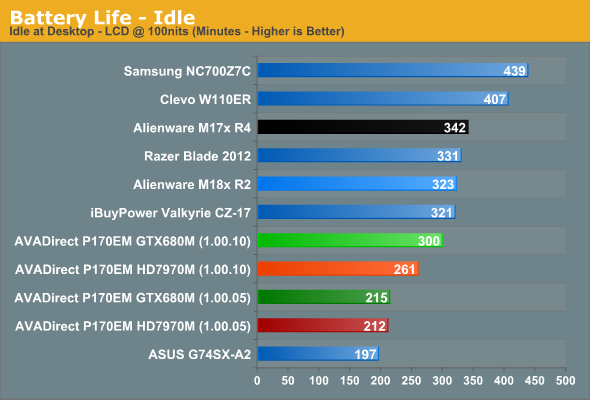
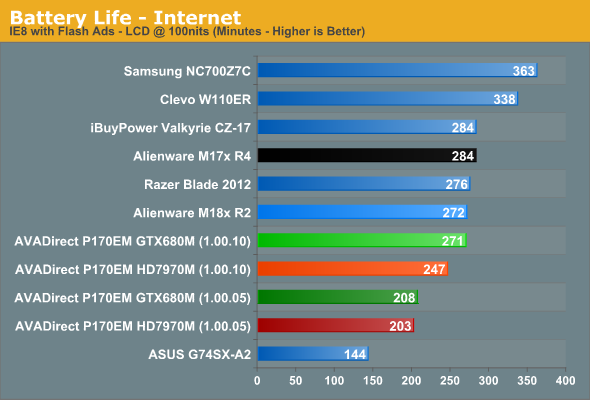
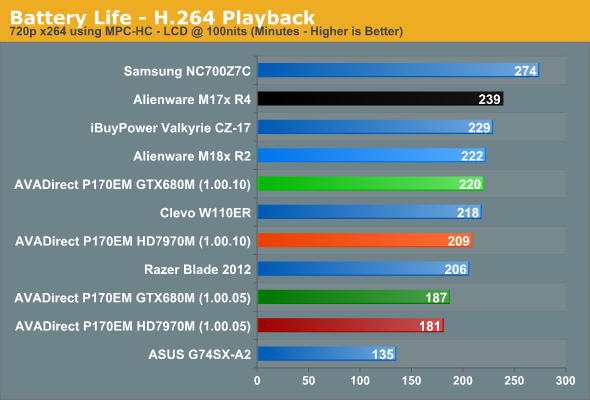
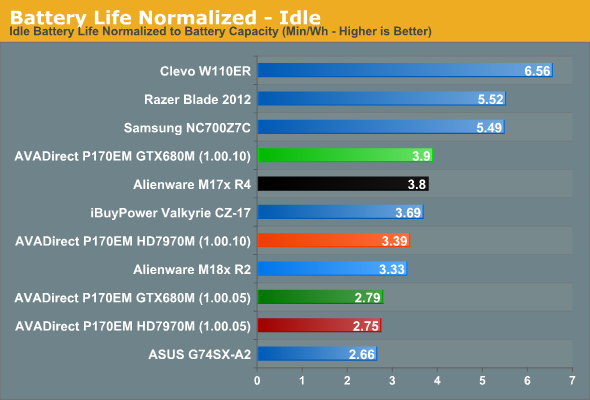
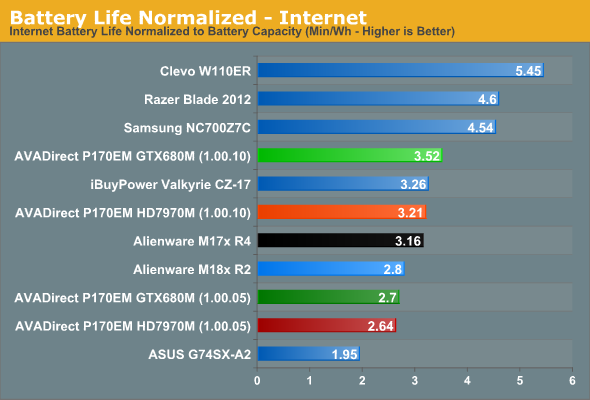
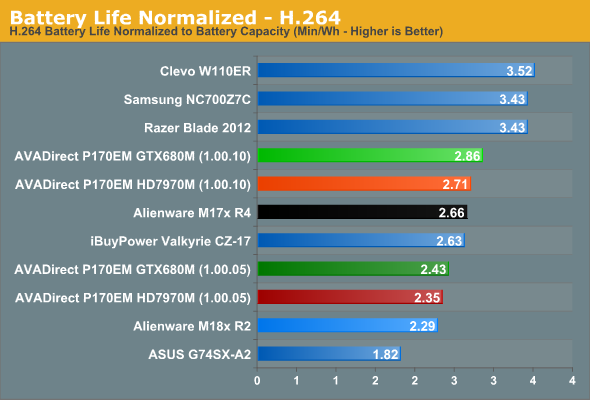
Oh what a difference a BIOS makes. We’re still nowhere near matching the prowess of designs like the Samsung Series 7 or Razer Blade, but we’re dealing with a substantially larger chassis that has the ability to support three spindles plus an mSATA drive—not to mention FireWire and several other seldom-seen features. I still feel like both the Alienware M17x and the P170EM could do better with further optimizations, but at least with the updated BIOS/firmware Clevo is able to surpass the normalized battery life of Alienware in most cases.
While the battery life improves on both laptops with the updated BIOS, it’s perplexing that the HD 7970M version is using substantially more power—idle power draw is ~15.1W for the GTX 680M compared to ~17.3W for the HD 7970M. We’re not using the same physical notebook of course (so there’s a different LCD, motherboard, battery, etc.), but even so that particular result is more than a minor deviation. Power draw during our Internet test is ~16.7W for the 680M vs. ~18.3W for the 7970M, so it’s a bit closer, and for H.264 playback the 7970M draws ~21.7W vs. ~20.6W for the 680M. Basically, the higher the loads on the system as a whole, the closer the two notebooks are in battery life and power use.
But despite the above concerns regarding AMD vs. NVIDIA, the fact is the P170EM is a large gaming notebook and battery life is only a secondary (or tertiary) concern. It’s good to see close that we’re able to hit around 4.5 hours of moderate use on battery power, and that should be enough for most people. Sure, if you fire up a game (or happen to come unplugged), your battery isn’t going to last that long, but if you’re trying to bulk up by carrying around a 10+ pound notebook + accessories at school you could conceivably get through four hour long classes before you need to plug in. I should also note that charging times are quite reasonable for the battery, taking under two hours to reach 100% even when you’re putting a significant load on the system; that’s where having a large enough power adapter is beneficial: under full load, the P170EM still doesn’t come near the 220W rating of the power brick.










58 Comments
View All Comments
Zodiark1593 - Monday, October 15, 2012 - link
Think we can get a comparison of the GTX 680M SLI vs the Radeon 7970M Crossfire?Also, do Clevo laptops that come equipped with dual GPUs also rely on a muxless design?
sabot00 - Monday, October 15, 2012 - link
"That’s a cost increase of 15% for a typical gaming performance increase of around 20% at high quality settings"I disagree with this reasoning, as a laptop also does many other things, many of which (CPU, HDD, RAM, internet performance) don't increase with the price.
This is analogous to saying that one can purchase a 256GB 830 SSD for $160, which is only around a $40 premium over a 1TB laptop HDD. Then claiming that this new laptop has 600% more performance in random 4K reads for only a $40 (2% increase for a $2000 laptop) premium.
While important to many people, especially buyers of these laptops, it's ultimately up to the buyer to decide, and as such, the premium for a purely graphical upgrade should not be weighed against the total cost of the laptop.
The 7970M is ~$450, in terms of OEM price, the GTX 680M is $650, truly, it is a 44% percent increase in price of the graphics subsystem for a 20% increase in graphics performance.
JarredWalton - Monday, October 15, 2012 - link
I'm speaking to people shopping for a gaming notebook. Since you generally can't purchase just a GPU upgrade (you can try, and in some cases it might even work -- some older Clevo units at least have managed to run multiple generations of GPU hardware), you have to buy the whole package. Yes, it's 40% more for 20% more performance when just looking at the GPU, but unlike desktops you can't just look at the GPU upgrade cost. Also, anyone buying HDDs without an SSD for the OS/apps just doesn't know what it's like to have a system boot and load apps quickly. Once you go SSD, you'd definitely pay double the price for one fourth the capacity and count yourself lucky.krumme - Tuesday, October 16, 2012 - link
Going by your logic, every gamer should buy a faster gfx for their rig. As total cost always will make the faster gfx a better choice. When does it end?You can explain all you want, but your reasoning stands as one of they most idiotic this year, and makes this look like a commercial.
Man even Nvidia nor AMD would ever come up with such an argument.
Think about applying this logic to rest of your purchases. Damn.
cjb110 - Tuesday, October 16, 2012 - link
I think if your looking at laptop gaming then yes the logic of buying the fastest gfx is sound. Laptops still have more of a mismatch between the capability of the cpu and the gpu. i.e. the CPU isn't the bottleneck.I don't think any one at AnandTech would apply the same logic to desktop gaming. In desktops its more even, so making sure the two are matched will save you money.
krumme - Tuesday, October 16, 2012 - link
No ssd, 768 15 pathetic screen, lousy build quality?274 usd brings you a long way of improving your rig.
Its the first time i hear the argument in 20 years on the www, and for a good reason.
JarredWalton - Tuesday, October 16, 2012 - link
No, it's not the first time the argument has been made. We frequently discuss the value of upgrading to a faster GPU in our desktop GPU reviews. If you look at an HD 7770 GPU that costs $125 and compare that to a 7870 at $240, is there value in the upgrade? Yes: it's substantially faster (nearly twice as fast), which opens up the possibility for 1080p gaming in most titles. Then we look at the HD 7970 and it's $410 but is only 20-30% faster. It's no longer a stellar upgrade.Here, we're looking at the total cost with gaming as the main purpose for buying a gaming laptop. It's okay to think people buying gaming laptops have more dollars than sense, but assuming someone wants a high performance gaming laptop, they're going to be shelling out minimum $1800 for something with HD 7970M or GTX 680M. So, if you have to pay $200 more to swap out AMD for NVIDIA hardware, is there value there?
The answer is a resounding yes. Sure, the 20% performance increase is nice, but it's about more than the performance. I specifically note the driver situation (twice in the conclusion alone). Given the option between Enduro and Optimus, right now you're shooting your gaming laptop in the foot if you go with Enduro. AMD has to fix this, and I think they will fix things, but that doesn't change the fact that they've been selling 7970M for four or five months with a major lack of driver support. Talk to me in another month, and hopefully I can say that it's no longer a major sticking point, but today? Nope, AMD's solution is hamstrung.
krumme - Wednesday, October 17, 2012 - link
The argument about driver and the quality of optimus is completely valid in my world. I have good experience with the optimus gaming laptop i have, and would always favor stability. Enduro is not working yet. Its very simple for my personal preference.But when buying a rig, you are always torn between where to put your money.
Do you prefer a gaming rig with an ssd and better screen to a faster gfx? - its not up to the reviewer to be the judge here. And present it as the truth. The reviewer can present the facts, and then the consumer, can make the right choises based on his own needs. The reviewer should be the guide.
JarredWalton - Wednesday, October 17, 2012 - link
You're reading a review, which inherently has subjective opinion -- a full page of it earlier, obviously, but the conclusion has a lot of subjective stuff as well. It actually *is* a reviewers job to be a judge; otherwise I should just run the benchmarks and post graphs and I could be done with a review in a day or two rather than spending a couple weeks running and evaluating. It's not a laptop review if all you're doing is showing performance and the price. You need to evaluate how the whole package comes together.People can certainly disagree with me and say, "I don't personally need or want to spend the money for an SSD." Or, "I think the 7970M is the better graphics card [because...]" That's fine. But my opinion is that when looking at the cost to buy a well equipped P170EM for gaming purposes, the additional money required to go from 7970M to 680M is definitely the way to go. If the extra $275 at AVADirect for that particular upgrade is "too much", you should NOT be buying a gaming notebook that costs $1500+ in the first place.
krumme - Wednesday, October 17, 2012 - link
The recommendation of the more expensive alternative is wrapped in numbers, presenting it as objective fact.When what happens is comparing total cost to a single benefit, albeit the most important one. Its inconsistent, and presented the wrong way imho. Its very simple just to say its say 15-20% faster, then the buyers can make up for themselves.